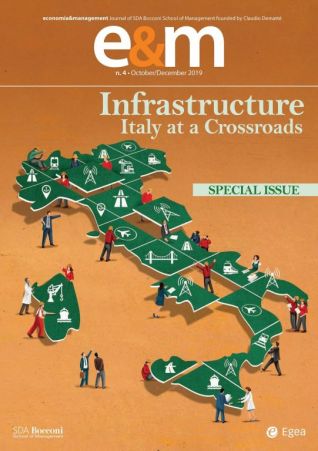E&M
2019/4
Development and Wellbeing A Question of Works
The economic development and fortunes of States over the centuries have been sustained and often conditioned by the construction of infrastructure. This has allowed many backwards and economically depressed regions to reach excellent levels of prosperity. In addition, the system of infrastructure has had, and still has, an evident geopolitical impact. In that regard, the Treaty of Rome of 1957 expressly provided for a common transport policy in order to develop a single European market, identified as one of the pillars to launch the path towards continental unity.
Stressing the importance of having adequate infrastructure (for transport, energy, digital, and telecom) should be entirely superfluous. Infrastructure is indispensible for the functioning of the economy (for both businesses and workers), but also for the satisfaction of citizens' needs and quality of life.
From a historical point of view, economic development and the fortunes of nations over the centuries have been supported and often conditioned by the construction of infrastructure adequate for the times. Suffice it to reference to the road system created by the Romans, that was the pillar of the Empire's expansion, and then in the centuries after its decline was the basis for the development of urban agglomerations and states in Europe.[1]
Thanks to the presence of adequate infrastructure, many regions were transformed from backwards and economically depressed to much higher levels of prosperity. Consider the Canton of Ticino in Switzerland, with the San Gottardo train tunnel inaugurated in 1882, or Val d'Ossola in Italy, with the Sempione tunnel opened in 1906. Or if we look at the case of entire countries and continents, we can recall the impact of the Trans-Siberian Railway from Moscow to Vladivostok (and then on to Beijing) completed at the start of the last century, and also the development of the railway networks in the United States, that was the basis for expansion from the Atlantic to the Pacific Ocean and the true unification of the country from the East to the West Coast.[2]
In addition, the infrastructure system had, and still has, an evident geopolitical impact. Without returning to the roads of Rome and the related works used principally for military purposes and the expansion of the Empire, there are many examples even today in which the geopolitical and economic dimensions are strictly related. The most evident case at the center of debate today, subject to very discordant points of view, is that of the "New Silk Road" (OBOR, One Belt One Road) whose value, according to many observers, goes well beyond the (convincing) economic motivations, as it is considered a fundamental tool for the pan-Eurasian expansion of Chinese influence.[3]
In Europe, the Treaty of Rome of 1957, in order to create the common market (the pillar of the political vision to launch the march towards European unity following the "functional" approach proposed by Jean Monnet and the Founding Fathers) expressly called for a common transport policy. Subsequently, the European Council Meeting of Essen (December 9-10, 1994) approved the first list of (fourteen) priority projects for the creation of the “Trans-European networks in the areas of transport, energy, and the environment.” Since then, the policy of the Trans-European Networks (TEN) has gone through important periods of development, including the constant increase and improvement of the financial supports available. The additional value of infrastructure is also increasingly recognized (for the environment, for example) to the point of the recent case of dual use projects being considered by European lawmakers, that regards the needs of mobility for military and security reasons (military mobility).[4]
As already stated, adequate infrastructure is indispensable for the proper functioning and development of the economy, but at the same time produces important effects not only once it is completed and enters into operation, but also in the construction phase. Investments in infrastructure are an important component of aggregate demand and GDP, and their construction mobilizes productive resources with both direct and indirect effects, due to its construction and the ancillary industries that are activated, respectively. This regards both new infrastructure (greenfield) and the improvement of existing structures (brownfield), as well as the important (but often neglected) activity of maintenance.
The investments in question are an important part of the economic cycle in which they can play an important anti-cyclical role, in particular during slowdowns or recessions, especially when they depend on public decisions (for funding, for example). However, the "other side of the coin" consists of the fact that those projects (due to the public component of their funding) can be the first victims of "austerity policies" (i.e. of limiting public spending), suffering postponements, and even drastic cuts or cancellations.
The centrality of infrastructure investments also makes them a crossroads for many complex questions with which they interact.
First of all, technological development and digitalization in particular have a fundamental impact on the creation of infrastructure. Just think of electric automobiles (and the need for recharging stations) or the possibility of self-driving vehicles, rail traffic control systems (that allow for high speed and high capacity rail traffic) and air traffic control systems, and Intelligent Transport Systems (ITS) more in general. Digitalization has a pronounced influence on transport and related infrastructure, for both freight and passengers. The changes in citizens' behavior (smart mobility, ITS, etc.) and improvements in quality of life are sustained by technological progress, but at the same time require adequate infrastructure (where adapting existing structures is often not enough).
The impact of infrastructure and means of transport is particularly important for the environment. Approximately one-fourth of atmospheric pollution originates with means of transport. As a consequence, there is an urgent request for technologies that respect the environment (i.e. rail instead of road transport) including as regards energy (renewable sources rather than fossil fuels) and the types of fuel used.
Important interactions also occur with business strategies. The global value added chain is pursued to increase efficiency and competitiveness, but it would not be possible without suitable infrastructure (transport, digital, etc.), which in turn stimulates development.
Lastly, we should cite the fairly futile contrast between "physical" infrastructure (such as large transport works) and "digital" infrastructure (5G and the Internet of Things), as if the latter could prevail to the point of substituting the former. To the contrary, there is strict complementarity in satisfying the needs of citizens and businesses. Smart mobility will require 5G to be increasingly smarter, but at the same time it will need a road or a railway to move from one location to another.
Another important question regards the fact that with only rare exceptions, infrastructure is a "public good," given that it is used collectively, regardless of whether it is funded publicly or privately. It satisfies not only individual needs (of citizens and businesses), but also the collective interest for economic and social development at the local, national, or transnational level (such as the TEN networks in the European Union). Furthermore, both its construction and its utilization can produce important positive and negative externalities. We thus find ourselves faced with a glaring case of "market failure," that requires appropriate evaluations and public intervention at least at the decision-making, authorization, and regulatory levels, in particular in the frequent case of "natural monopolies (and in the financial sphere as well, when required).
However, the creation of infrastructure can have an impact on single interests (that justifies expropriations for reasons of public utility, or other similar actions) or impacts that are localized and limited, which can lead to the emergence of protest movements, typical of the NIMBY (Not in My BackYard) phenomenon. It is difficult for the general interest to be mobilized in favor of a specific project, while particular interests who are against it (for reasons regarding ownership, prejudice, ideology, or simply to seize the opportunity to protest) can be organized effectively, noisily, and even violently at times. This can be prevented and countered with the adequate involvement of public opinion (as expressly required in some countries) with appropriate forms of communication. Forms of compensation are also often used, that at times, however, risk leading an unjustified explosion of the costs of the works.
So it seems necessary to bring infrastructure planning back to the center of the debate without ideological or simply factionalist impediments (that seek to protect particular interests). Great responsibility lies with the political class and experts in the complex subject matters involved, as they must ensure that the public interest is central, with a medium to long-term horizon. The issue must absolutely not be used in order to win public support, but rather as an essential tool to design a path of economic and social development, compatible with the available resources. This requires first of all offering citizens the elements for a correct evaluation of the stakes involved, in order to allow them to consciously participate in decisions on which their quality of life and future depends.
SYNOPSIS
- Investments in infrastructure not only come under the responsibilities of the public sector, but are also particularly interesting for the financial market and for private investors with a long-term orientation (insurance, pension funds, etc.). In addition, they are a fundamental factor for economic and social growth and for the competitiveness of enterprises. In the transport sector above all, they can provide a decisive contribution to environmental sustainability, and in the construction phase they play a role in supporting GDP and employment, acting as an important element of anti-cyclical policies.
- Infrastructure also has geopolitical value, as demonstrated by the commitment of some large players in the sector (starting China and the "New Silk Road").
- Infrastructure development policy requires adequate forms of communication and involvement of public opinion, so that NIMBY (not in my backyard) approaches do not prevail over the general interest.
- Technological progress and digitalization have an important impact on new infrastructure and updating of old infrastructure. In turn, investment in infrastructure stimulates technological progress and the spread of digitalization.
See C.-J. Dalgaard et al., "On Roman roads and the sources of persistence and non-persistence in development," VOX, CEPR Policy Portal, April 10, 2018.
See C. Wolmar, Blood, Iron & Gold. How the Railways Transformed the World, London, Atlantic Books, 2009.
Comments and analysis of the advancement of the project are offered regularly by "OBOR Watch" produced by ISPI (www.ispionline.it).
See C. Secchi, "Il valore delle infrastrutture," Economia & Management, No. 1, 2019.




